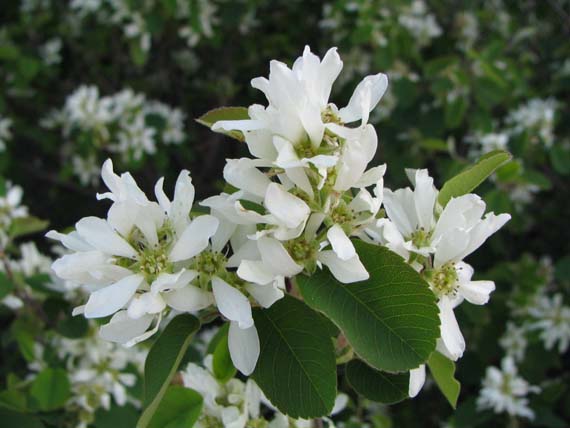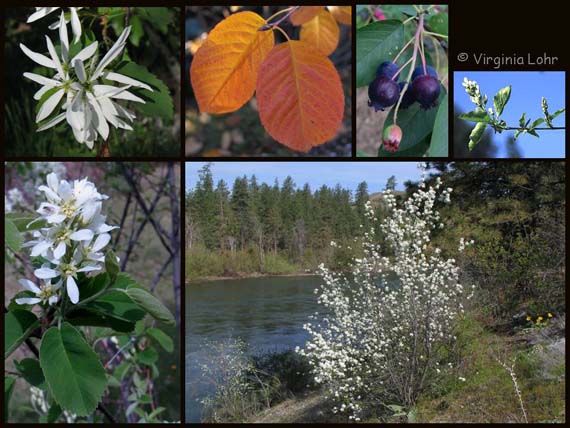Amelanchier alnifolia
Western serviceberry

Plant form |
Deciduous, flowering and fruiting, upright, broad shrub. Plants have multiple stems. Most also form suckers, but there is variability in this trait among different cultivars; some produce many suckers and others produce few. |
Size |
6-20 feet tall, with similar spread. |
Leaves and stems |
Dull green during the growing season and browsed upon by deer, elk, and moose. Develops attractive fall color, including red, orange, bronze, and yellow. Bark is smooth and light gray. |
Flowers |
Blooms in spring for a brief period. White flowers are in small clusters. Can be quite showy, especially in ecotypes native in eastern Washington. |
Fruit |
Fruit is bluish-black when ripe in late summer. It is juicy and edible. The versatile fruit may be used fresh or dried, cooked or raw. It is a common food source among Native Americans, and it is a component of mincemeat. It can be used the same ways as blueberries. Popular with wildlife. |
Native area |
Central and western North America. Found throughout Washington state. |
Water use |
Low. |
Culture and maintenance |
Grows well in a wide range of soil types. Prune to shape. Larger cultivars may be trained to look like small trees. May get aphids. Some are susceptible to powdery mildew or leaf spot; others are resistant. |
Light |
Full sun or partial shade. |
Hardiness |
USDA Zone 5. Some cultivars are hardy to Zone 3, and a few are actually hardy to Zone 1! |
Cultivars |
Many cultivars have been developed for fruit production and may be available through specialty fruit tree nurseries. For a description of the features of different cultivars, see: Saskatoons by J.G.N. Davidson and R.G. St. Pierre in HortScience 29(9):959-960 (Sept. 1994). 'Regent' is a popular cultivar that may be available in local nurseries. We have grown this one. It is about 6-8 feet tall, hardy to Zone 3, and has some resistance to both powdery mildew and leaf spot. It has good burgundy and orange fall color and typical blue fruit. It produces a few suckers, but it does not sucker profusely. |
Other |
Also known as Saskatoon, Saskatoon berry, or Juneberry. Cultivars sold as Amelanchier alnifolia may actually be hybrids between A. alnifolia and other species of Amelanchier. |
Life is good at WSU.
Secondary content can be almost anything. If you are not using this region delete all the content that is in between the div tags with the id ="additional".
A unique richness of students, faculty, location, activities, and organizations creates a full, lively student life at the University. This section gives you the insider's view on student life and a sampling of the opportunities here.
"Glimpses." Students talk about life at WSU
These brief posts are written by WSU students to give you a personal look through their window on campus life.
